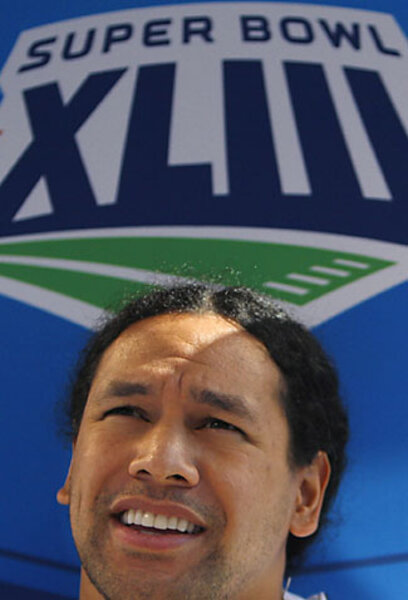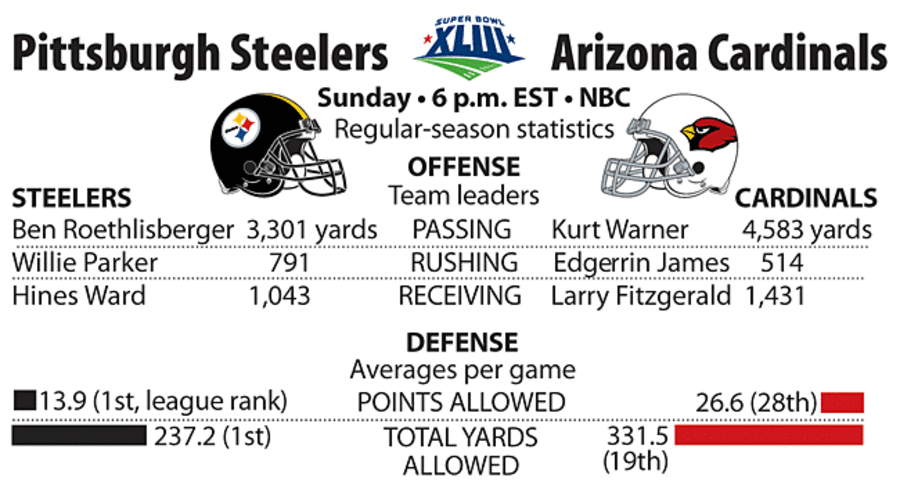'Steel Curtain II' vs. a big offense: a contest of styles
| Tampa, Fla.
Once upon a time, in the lean war years when bombs fell on London and Berlin, two American originals – the Cardinals and Steelers – joined forces.
They were the Card-Pitts. They were so bad the rest of the league called them "The Carpets."
This Sunday, that ill-fated experiment comes full circle, pitting two teams with an interconnected past against each other in Super Bowl XLIII at Tampa's Raymond James Stadium.
These days, the franchises have opposing game-time philosophies. The Cards, their offense led by former grocery-store stock boy Kurt Warner, face the Steel Curtain II defense and its wild-haired Greek Orthodox Samoan safety, Troy Polamalu.
The game will not only arc across history and put into crushing motion a mix of regular guys-turned-gridiron mavericks. It will also delve into the heart of a game that is being redefined in front of fans' eyes.
The adage that defense wins championships dies hard, but today's champions are more likely to rely on a balanced game plan built as much on offensive grit as defensive formations.
"The main story line is the dynamic offense of the Cardinals versus the defense of the Steelers and how these teams have built their squads," says Jeffrey Ohlmann, a University of Iowa researcher who does quantitative analysis of NFL teams.
Nimble as 250-pound ballerinas, the Steelers' front line in many ways defines an emerging style of fast but bone-crunching defenses. It's gotten the team to two Super Bowls in four years and is setting them up as 7-point favorites this Sunday. A win would give the Steelers a sixth overall title.
Engineered by 50-year NFL veteran Dick LeBeau, who sometimes amuses his players by doing push-ups on the sidelines, the Steelers are drawing inspiration from the team's 1970s-era Steel Curtain, which won four championships.
Anchored by pass rusher James Harrison, the league's best defensive player, the D's plan is to intimidate the front line and rattle Warner with blitzes – before the Cardinals quarterback can use his quick release to lob a game winner to one of three wideouts, who all have more than 1,000 yards on the season. Polamalu, who has traveled to Greece and Turkey to search for his faith, will unwind his prodigious locks and key in on Warner's eyes, becoming, as he says, "One with the game."
Arizona will try to counter with a high-flying passing game and, more critical, an emerging running game led by rookie running back Tim Hightower, who ran for 73 yards in the Cardinals' playoff win over Atlanta.
"They're the most aggressive defense that we'll face this year. We're going to have our hands full," says Cardinals defensive tackle Levi Brown.
Warner is a former Super Bowl winner and a father of seven who credits his Christian faith for his remarkable return to the top of the league. He's stabilized the sometimes volatile Arizona squad, famous for sideline confrontations between coaches and players. He's also taken the role of a grizzled leader who brought the team back from the brink of defeat against the Philadelphia Eagles two weeks ago.
Second in pass completions during the regular season, the graying Warner is flanked by a receiving duo: muscle-bound tackle-breaker Anquan Boldin, whose comeback from a crushing early-season hit has defined the Cardinals' toughness, and Larry Fitzgerald, who has amazed fans with his ability to catch balls with one hand and, sometimes, with his eyes closed.
Epitomizing the NFL's new focus on offense, the Cardinals often put a third receiver, Steve Breaston, on the line.
"Anytime you can make big plays in games, it really limits what the defense can do, and it doesn't really matter what kind of pass rush you get," says the Steelers' Polamalu. "So far, nobody's figured out how to stop Fitz [Fitzgerald]."
To be sure, defense still rules the Super Bowl. In the past 12 years, only four winning teams have had a top-10 offense, while nine of the teams have featured a top-10 defense, says Thomas George, a senior analyst with NFL.com.
However, Mr. George says, the domination of Warner and the Steelers' much-improved quarterback, Ben Roethlisberger, is likely to give this Super Bowl a decidedly offensive tilt. Both QBs are known to call their own plays.
"What's particularly evident in this Super Bowl is the fact that defenses have gotten better and a return to the QB getting more opportunity to take control of the game," George says.
Yet the Cardinals' greatest strength may come from its connections with the Steelers organization. Former Pittsburgh offensive coordinator Ken Whisenhunt is now the Cards' coach, his head full of intelligence about a Steelers squad that has hardly changed since he walked the chilly sidelines in Pittsburgh.
In addition, former Steeler John Lott, who is now the Cardinals' strength coach, has played a role in bringing the Steel City's working-class style to Phoenix, says Arizona offensive linebacker Karlos Dansby.
"We cut over 300 pounds of fat over the off-season as a team, and we've been rolling ever since," says Dansby. "We admire stuff like that when you see guys just coming out and ... making big hits."
Yet Arizona's defense plain stunk in the regular season, giving up only one point fewer than the offense managed to score. But it's a different story in the postseason: The team hasn't given up 100 rushing yards in a game yet and has seven sacks total in the three playoff games (compared with 31 for the 16 games of the regular season).
"We're just going out and playing freely, and I guess everyone else has been tensed up," explains key defensive tackle Darnell Dockett, a first-time Pro Bowler. "We love being the underdog. We love being called the worst Super Bowl team ever."






